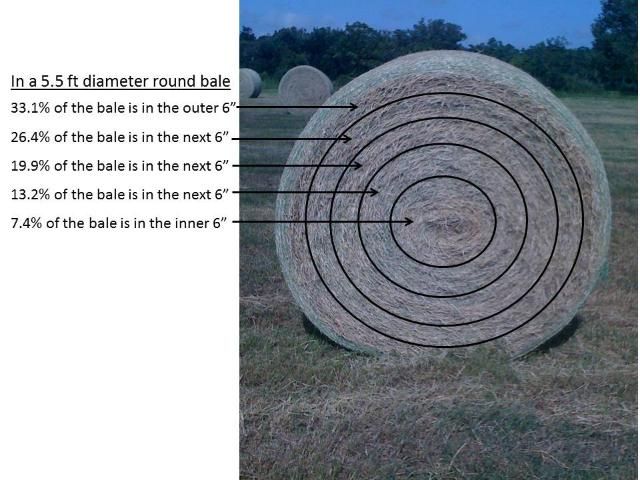The dimensions of large round bales make a difference in many cases. Bale size determines the amount of hay in a purchased bale, the amount of nutrients in pounds, and the extent of spoilage during storage and feeding.
Large round bales, the predominant form of hay made and fed to cattle, are under discussion. Large round bales are produced with a number of different dimensions (diameter and height), which result in different total bale volumes. Volume combined with bale density results in the total weight of the bale. Table 1 demonstrates the impact that bale dimensions have on the total weights when the density is constant for all bales. If a 5x5 bale is standard, then bales with smaller dimensions have proportionally less weight and less value, and bales with larger dimensions have proportionally more weight and greater value. A 4x4 bale is approximately 50% of the size of the standard bale, whereas a 5x6 bale is 44% larger than the standard bale. Additionally, the total weight of a bale of any given size increases as bale density increases. Decreases in bale density result in lower total bale weight. Optimal bale density is a function of the hay baler, forage product being baled, and desired final bale weight. The value of a hay bale is determined based on the actual or perceived nutritive value of the bale and its actual or perceived size. The direct relationship between size and monetary value becomes more important when bales of different dimensions and weight are priced equally on a per bale basis. If all bales have an equal value, then smaller, lighter bales result in a greater cost on a per ton of hay basis because more bales will have to be purchased to equal a ton of hay. On the other hand, larger, heavier bales decrease the cost per ton of hay because fewer bales are required to produce a ton of hay.
In practice, cows do not consume every pound of conserved forage that goes into a large round bale. In fact, there are losses associated with hay bale storage that can range from 5% for bales stored inside a building to 29% for bales stored on the ground with no cover. See EDIS publication AN266, Comparison of Hay or Round Bale Silage as a Means to Conserve Forage (https://edis.ifas.ufl.edu/an266), for a full list of storage loss amounts. In Table 1, a 10% loss for storage is assumed and the amount of hay available from each different bale size is indicated. It is important to note that not every pound of hay that is delivered to the cow herd is consumed. Cows will waste hay through selective eating, trampling, soiling, and using the hay as bedding. The amount of hay loss depends upon many factors, including forage maturity, forage type, hay bale feeding method, and time of year. In Table 1, a 5% feeding loss is assumed and the amount of hay that would still be available for consumption from each bale size is indicated. The numbers calculated in Table 1 show that the amount of hay that was originally baled into the large round hay bale and the amount of hay that the animal will consume differ greatly. Finally, factoring in the consumption of an average cow, the estimated number of hay bales that would be required to supply the hay needs for a 25-cow herd is determined. Between the largest and the smallest bale sizes, there is an 80% difference in the number of hay bales required for the cow herd in a week. These hay needs only refer to the amount of hay consumed, not the quality of the hay product. Keep in mind that the number of hay bales required on a weekly basis also affects the number of trips with a truck or tractor and the labor expense associated with hay feeding.
Figure 1 shows the proportional amounts of hay that are contained within each of the five 6-inch concentric rings of a 5.5-foot diameter hay bale. 33.1% of all the hay in a large round bale is in the outer 6-inch ring. The majority of storage and feeding loss occurs in the outer 6 inches in a large round bale. As bales become smaller, the outer layer becomes a greater part of the total bale. Therefore, as bale size shrinks, the potential for increased storage and feeding loss increases. Storage and feeding losses deprive the cows of nutrients and increase the buyer's expenses. A bale that costs $45/ton of hay now costs $51.75 with 10% storage loss and 5% feeding loss.

Credit: Matt Hersom, UF/IFAS
When purchasing hay, consider its weight rather than bale size. Cows do not need to consume hay by the large or small bale. They consume a defined amount of feed in pounds of hay to meet their intake requirement. That said, small bales that are not priced appropriately, stored correctly, and managed for proper feed-out present a variety of management issues. Purchasing hay on a bale size basis rather than a weight basis can result in unnecessary spending on smaller, undersized bales. Consider what you are buying in a large round hay bale. Is there value in the product? Is the hay bale everything that it needs to be?
References
Banta, J. 2012. "Bale weight: How important is it?" Texas Agrilife Extension. Extension document E-319. Acessed on April 18, 2016. http://beeffax.tamu.edu/files/2013/09/2012-Bale-weight-how-important-is-it-Banta-E-319-.pdf
Hersom, M., T. Thrift, and J. Yelich. 2010. Basic Nutrient Requirements of Beef Cows. AN190. Gainesville: University of Florida Institute of Food and Agricultural Sciences. http://www.edis.ifas.ufl.edu/an190
Hersom, M., T. Thrift, and J. Yelich. 2014. Comparison of Hay or Round Bale Silage as a Means to Conserve Forage. AN266. Gainesville: University of Florida Institute of Food and Agricultural Sciences. http://www.edis.ifas.ufl.edu/an266